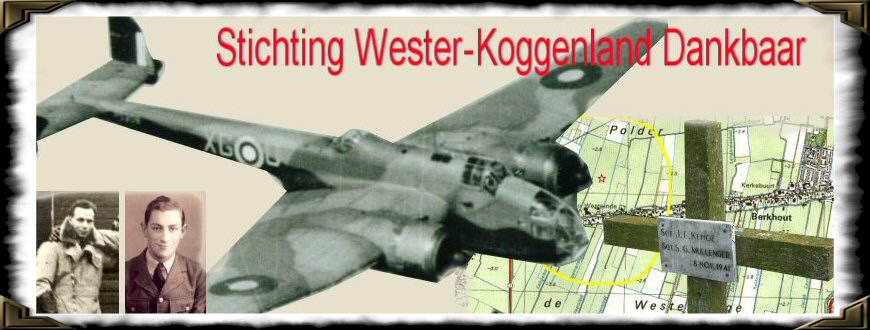


For the last news,
look at the main page. The newest articles have an link to an English translation..
Earlier in the news:
The story of Isabel Conway
in The Independent online
Irish
air ace shot down in 1941 to find peace at last
Read the newest interview with Sheila Hamilton here
.jpg) |
It is a simple cross, dedicated to the memory of RAF airmen, shot down over the Netherlands. Erected by grateful Dutch citizens to honour the ultimate human sacrifice paid to end their misery at the hands of the Nazi invaders. But this cross at the side of a field near Berkhout, a village in North Holland, is the silent witness of the struggle for the repatriation of an Irishman, whose family wants his remains returned to them.
The cross marks the wreckage of a Hampden bomber shot down by a German night fighter on the evening of November 8, 1941.The plane crashed in Berkhout, 50km north of Amsterdam, and there were no survivors. Inside the wreckage below the ground lie the remains of the Irish airman John (Jack) Kehoe and the British Stanley Mullenger. |
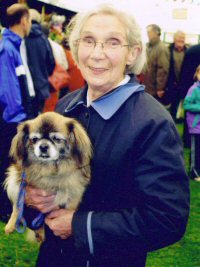 |
Following years of searching his sister Margaret Walsh-Kehoe (86), has managed to pinpoint the exact spot where Jack Kehoe has laid, together with his British colleague Stanley Mullenger. She did this with the help of the Dutch foundation DARE (set up to research, locate and excavate missing aircraft) | 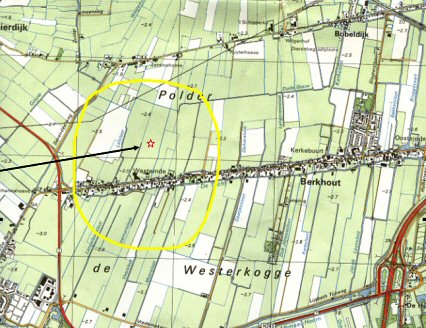 |
|
In november 2005, mrs Walsh came with her daugher and granddaughter to Holland for a memorial service to mark the 64th anniversary of Jacks death. |
.jpg) |
To fulfil her mother’s deathbed wish to have her son returned home one day, Margaret Walsh is determined to have her brother’s remains recovered from the wreck and taken home to Ireland 'for a Christian burial'. She doesn't want him to stay 'in a potatoe field'.
Mrs Walsh spent many years hunting for her missing brother. She persevered and received invaluable assistance from Dare, a foundation dedicated to examining the history of air battles above Dutch territory. It was a time consuming search but they are certain that the Hampden bomber buried in the field at the Westeinde in Berkhout contains the remains of the two airman. The pilot and co pilot, Christopher Saunders and James D'Arcy, were thrown out during impact. Their bodies are buried in the Military cemetery at Bergen.
Now at last she knows where her younger brother’s remains are, but it would not be that easy to fulfil her mother‘s dying wish and have him brought home to Ireland as complications arose.
In accordance with the Geneva
Convention, governments in whose country non natives have been buried due to
hostilities, must on request of the family members facilitate and simplify the
return of the remains to the country of origin. At least, they have an obligation
to do the upmost.
In Holland the mayor of the community where an airplane has come down has the
power to decide whether war wreckage should be left where it is or excavated.
It is the opinion of mayor Sipkes of Wester-Koggenland that the plane has to
be regarded as a field grave and should not be disturbed. She insisted that
relatives of the second airman who is buried with Sgt Kehoe in the wreckage
must give their consent before there is any attempt at recovery. That second
airman is Sgt Stanley Mullenger, who came from Essex.
After ongoing contact between the Irish and British embassies in Holland and a search via British newspapers such as The Sun and an evening paper in Essex, a nephew of Mullenger was located. That nephew, Ian Sharpe, is the son of the sister of Mullenger. He found ten surviving relatives, one of them living in New Zealand. They were informed that their long deceased uncle and grand uncle was buried under a Dutch field and they were asked if they would have any problem with an excavation.
At that time it became exciting,
because if the British family was not in agreement to raise the wreckage in
order to re-patriate Sgt Kehoe, there was a strong possibility that nothing
further could be done. The Irish family, who are supported by the Irish embassy,
would stand with empty hands.
A member of the Dutch parliament asked the Dutch State Secretary for Defence to look into the request and ensure any barriers are removed. Legal advice was also being taken to look into the Irish family’s rights under the Geneva Convention versus the local mayor’s decision to leave the wreckage where it is, if the second family did not want the remains of Sgt Mullenger disturbed.
| But, fortunately
for the Irish family, the British family unanimously said Yes. Ian Sharpe
visited the crash site on March 17th, 2006. For pictures of the visit, click on the photo. |
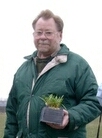 |
But that was only the first step. It didn't mean that a decision can be made quickly. First a preliminary investigation has to be carried out to find out if the excavation is technically and financially attainable. Not earlier than in may the request for such a preliminary investigation was sent to the institute of the dutch airforce. The excavation officer, Hans Spierings, has estimated that it could be september before the excavation can be started.
It takes that long because a lot of permits have to be requested, among others for environmental reasons. A specialized company has to be brought in to do the digging. A company that has the ability to approach possible bombs or ammunition that is still in the bomber or ground.
Local people, moved by the long search of mrs Walsh and her wish to have her brother buried in consecrated ground have formed a foundation, Wester-Koggenland Dankbaar, to raise funds towards the excavation costs.
But first, the council of
Wester-Koggenland has to decide if any excavation can take place. Everyone waits
for the preliminary investigation to take place.
In the meantime, the search is started to find relatives of the pilots, D'Arcy
and Saunders.
Here you can listen to Ed IJsbrandij from DARE in a radio
broadcast of BBC Wales (3 MB download wav-file)
Here
you can read an article on www.thisislincolnshire.co.uk
Here
you can read an article on www.gainsboroughtoday.co.uk, (june 1, 2006)
Here you can
see a print of the article in The Gainsborough Standard (june 2006)
| June: The search for the relatives has lead to the finding of Mary Irving-Wrighton, who was engaged to be married to John Kehoe! This gives the request for the excavation an extra dimension. | 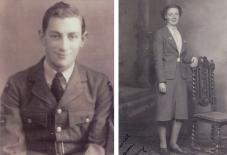 click on photo for a bigger size |
Sheila Hamilton, one of
the daughters of Mary, told us that her mother met Kehoe in 1939, while he was
working on the radar in Kirkwhelpingon, above Belsay near Newcastle. She was
16, he 18. When war break out, he wanted to fly on an RAF-bomber. Mary told
him that as an Irishman, he didn't have to, because Ireland was neutral in WWII,
but he choose for it, Sheila said. ,,It was a true love story''. Mary was supposed
to go with John to Ireland and meet his family on his next leave in 1941, but
he was shot down on the 8th of november. Instead of a telegram with details
about the visit the parents of John became a letter that he was recorded as
missing.
Mary never forgot John, Sheila said, but she did went on with her live. Married,
and got six childeren. She never knew where he was burried. A couple of years
ago, Sheila and her sister Cynthia started with an attempt to trace John Kehoe
and his family. Via via, Sheila found the 49 Squadron Association, read about
the last mission of Johns Hampden P1206 and spoke to several people, but no
one could help them.
| The Ilkley Gazette placed an article about the search of Sheila on 23 november 2003. |
Not much happened until
may 2006. A lawyer, Alan Walker, who responded to the search of DARE, came in.
One of his phone calls was with people of the 49 Sq. Association. They did remember
the questions of Sheila....
Mary Irving-Wrighton (83) will sent a letter to Margaret Walsh-Kehoe (86), the
sister of John, as a first contact after more than 60 years. ,,It is truly amazing'',
Sheila says. ,,After over 60 years people are still finding loved ones that
fell far from home. I am sure that mum will do anything she can if it helps
Margaret get him home.''
Investigation has started
On the 8th of June, the
preliminary investigation has started officially. The mayor of Wester-Koggenland
expects to know in september or october what the costs are and if the excavation
is attainable.
On june 12, John Gilroy, the second secretary of the Irish embassy and an British
assistant defense-attaché had a meeting with mayor Sipkes of Wester-Koggenland.
That took place in the British embassy in The Hague. Gilroy has contact with
the Walsh family since their request to bring the remains of John Kehoe home
to Ireland.
Purpose of the meeting in june was to find out what the procedure is and what
the the Irish and British embassy can do to remove any stumbling blocks. Gilroy
said it was an informal conversation, that fits in the wish of the Irish government
to stay in close touch about fulfilling the wish of the Walsh family.
If an excavation will be conducted, the standard procedure is to keep the crew
of the plane together, and give them a grave on a commonwealth cemetery. In
this case, the next of kin of John Kehoe want to take him back to Ireland. Key
issue is the question if it is possible to identify the remains of John. But,
Gilroy said, ,,We have to take one step at the time. It's a long way between
now and then.'' Real decisions can be taken if there are facts, he said. The
preliminary investigation should give some answers in august, september. Gilroy
thinks that if an excavation is attainable, it will be spring 2007 before it
can be carried out.
|
|
A team of the Explosive Ordnance Disposal (EOD) of the Royal Netherlands Air Force has found large amounts of iron on the crash site. The measurements were taken August 22. In an area of approx. 80 by 80 feet, deviations of geomagnetism were found on a lot of places. That means that on those spots, a lot of large iron objects are under the ground. Spread out on a surface of 36 by 65 feet. Not all of the plane can be traced this way, for instance the aluminium doesn't give a deviation and therefore is not visible. But engines, wheels (and bombs, if any) can be found. The commander of the EOD-team said that the measurements have made clear that the plane is on that spot. The team also searched on another place, near Ursem, a few miles west of Berkhout. An American Liberator bomber crashed there on 29th of june 1944. They found large amounts of iron on that place too. The exact place of a bomb, near the Teding van Berkhoutweg in Berkhout, still isn't known. The EOD-team has to come back for this. A witness who saw the bomb fall in april 1945 has pointed out where this bomb probably is. The municipality of Wester-Koggenland wants to take all possible excavation places into the project, because of the contribution they need from the government. Pictures of the measurements can be found here
|
Meanwhile, on the Irish
side (but also on the Dutch), people involved become more and more impatient.
They understand things have to be arranged, but don't understand why it takes
so long. It's about 18 months ago, Margaret Walsh made a formal request for
the excavation, to recover the remains of her long lost brother and bring him
home to be buried in Ireland. And after these 18 months, Wester-Koggenland still
works on the preparation of a proposal.
An Irish friend of the family Walsh, Michelle Callinan, has written a letter
to the Dutch crown prince, Willem-Alexander and his wife, princess Maxima. She
asked them to help Margaret Walsh. She hopes they will use their influence to
speed up procedures. The answer she got came from the Dutch minister of defense,
Kamp. He wrote that the council of Wester-Koggenland will make a decision by
the end of october, beginning of november. But the mayor of Wester-Koggenland
said on september 14th, in the monthly meeting of the council, that she's afraid
this date can't be reached. Too much data isn't present yet. To make a proposal
it is necessary to know if the excavation is technically and financially attainable.
There has to be another investigation, by a specialized company, of the ground
and environment of all the three places, Wester-Koggenland want to dig.
A new problem comes up, since Wester-Koggenland is going to merge with the municipality
of Obdam at januari 1, 2007. On november 22 there are elections for the new
council, and the current council of Wester-Koggenland will have the last meeting
on november 16. ,,I understand the impatience of the Irish people, but we have
to have more data to take further steps.'', mayor Sipkes said on september 14.
3 october, 2006
It becomes clear that the council of Wester-Koggenland is going to discuss on
october 12th the paying of 25.000 euro's for the last part of the preliminary
investigation (research of environment and bottom around the planes in Berkhout
and Ursem). Companies who are capable of doing that investigation allready are
asked by Wester-Koggenland to send in their tender. This investigation has to
make clear if - and where - there is pollution of oil and other substances in
the ground, and what steps have to be taken to preserve the environment while
executing an excavation.
When the preliminary investigation points out that the excavation is technically
and financially possible, the council will have to make a decision.
7 october, 2006
The council of Koggenland will decide in march 2007 about the excevation of
the bombers in Berkhout and Ursem. Koggenland is the name of the new municipality
that is formed by the merge of Obdam and Wester-Koggenland. The council of Wester-Koggenland
received an overview from what has past and what's in the future, from the mayor
and her aldermen. The investigation of ground and environment, about which the
council decides at 12 october, could begin this month and will take 8 to 10
weeks, according to the overview.
|
Meanwhile, as it looks like the excavation is likely to be carried out next year, the foundation of Dare tries to find relatives of the crewmembers. British lawyer Alan Walker managed to trace the twin daughters of the pilot of the Hampden, Christopher Saunders. Jackie and Frankie
Saunders (now 68) live in a village near Oxford. Over 30 years ago, Jackie and Frankie have visited the Commonwealth War Cemetery in Bergen, where Chris Saunders and James d'Arcy were buried. They intend to go to Berkhout in the spring or summer of 2007, to see where their fathers plane really came down.
|
12 october 2006
The council unanimously decided to pay 25.000 euro for the investigation of
ground and environment. Councilmember Jim Mollet blamed the mayor and aldermen
for causing a delay because they had suddenly extended the investigation with
another bomber and two solitary bombs five months ago. He emphasised the primary
goal: repatriating the body of John Kehoe in such a term that the next of kin,
his sister Margaret (87), still lives to see it happen. But he stood alone.
The other councilmembers want to treat the matter very careful and take step
by step.
26 october 2006
On the 8th of november, Margaret Walsh, members of her family and a large group
of people from England will come to Berkhout for a ceremony on the field where
the plane lies. On that day, it is exactly 65 years ago the Hampden crashed.
The Irish embassy has asked pastoor Jan Berkhout to conduct a small service
on the spot. Sheila Hamilton, daughter of Mary Irving (the nurse John kehoe
became engaged with while in England before the war, see above) will lay a wreath
at the ceremony. She will do that also on behalf of the 49 Squadron Association,
an association that provides all members and ex-members of 49 Squadron - where
the Hampden belonged to - with the opportunity to meet. Of 49 Squadron Association,
chairman Ted Cachart, who flew a Lancaster-bomber during the war, secretary
Alan Parr and boardmember Colin Cripps will be at the site.
RAF Scampton, the base of the Hampden, will be sending five personnel to the
memorial service. They will be in uniform and they also will lay a wreath. ,,The
major reason for our attendance is of course to commemorate our predecessors
from RAF Scampton'', commander Gary Mennell says. ,,However, we are also keen
to teach some of our younger recruits the ethos and history of the RAF. I can
think of no better way than attending a ceremony which recognises the courage
and sacrifice of those who died at Berkhout over 60 years ago.''
The story behind the aircraft recovery in Berkhout, especially the request of
mrs Walsh to bring her brother home to Ireland, will play a role in the documentary
'Memories in mud', two Dutch producers are making. Raoul de Zwart and Arthur
van de Starre, of the audiovisual productioncompanies Inbetween and ByTheWay,
have asked to do an interview with mrs Walsh and record the ceremony on the
8 of november. Since last year, they are busy making the documentary. Their
subject isn't the excevation itself, but the emotions of people involved, like
next of kin, veterans and eyewitnesses. Part of the documentary is the story
of Erich Ett, a German Messerschmitt-pilot, whose plane was shot down in 1944
and whose life was rescued by a Dutch nurse. Ett and the nurse, Toos Haaring,
were brought together for the documentary. The producers think the struggle
of John Kehoes 87 year old sister to give him a decent grave, that allready
took her two years, fits in the intention they have with the documentary. That
will propably be ready early 2007.
On the 8 of november, the memorial service was held. Pastor Jan Berkhout conducted a service on the spot where the plane crashed, that day exactly 65 years ago. The Walsh family was present, and a large British delegation including military personnel of the RAF and the board of the 49Squadron Association. Also Dutch people involved were there, like members of the family Schilder, the foundation DARE and the officers of the Royal Netherlands Airforce that will be responsable for the excavation.
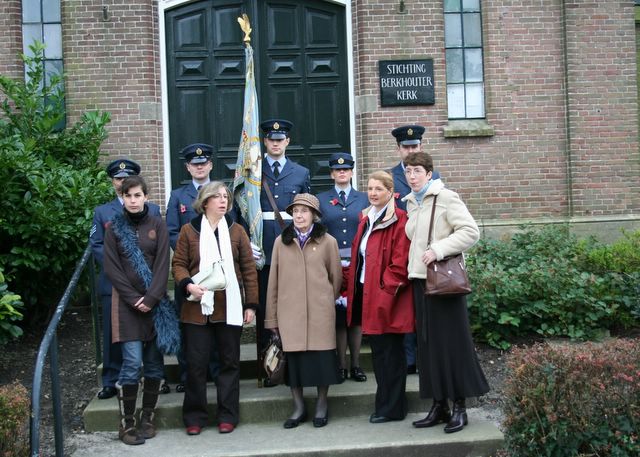
The delegation of RAF Scampton at the church in Berkhout
with mrs Walsh-Kehoe and (from left to right) her granddaughter Allison,daughter
Margaret, Sheila Hamilton (daughter of John Kehoes fiancee) and daughter Carmel.
Boardmembers of the 49 Squadron Association, the association of the squadron the Hampden belonged to, looked with respect at the flag of the squadron. The RAF-people had managed to take it with them, allthough it meant they had to travel by car. Normally it is in the church of RAF Marham. On the flag are named all wars, since 1917, where the 49 Squadron took part in.
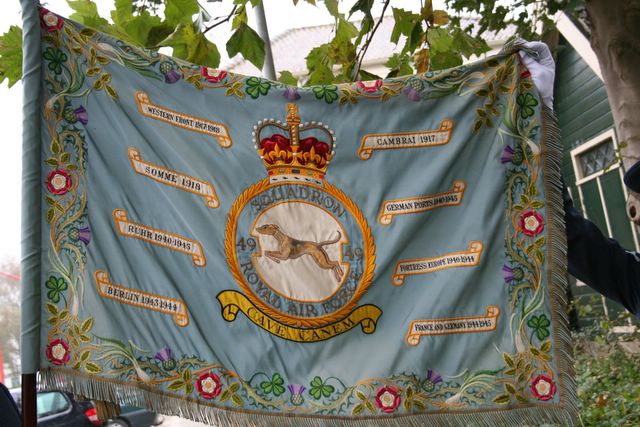
During the service, Sheila Hamilton, daughter of Mary Irving, read a letter of her mother. Her 83 year old mother wasn't emotionally ready to come to Berkhout, but her letter made clear she did - and will - never forget her 'dear sweetheart'.
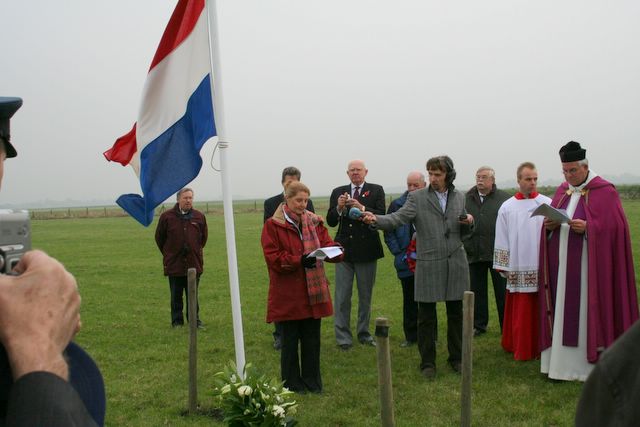
Pastor Berkhout
said that 'we in Holland are barely capable to understand how brave these people
must have been. Just as it is hard to feel the suffering of the people left
behind.'' Hij blessed the spot. ,,For this ground is sacred, by the sacrafice
that was made her.''
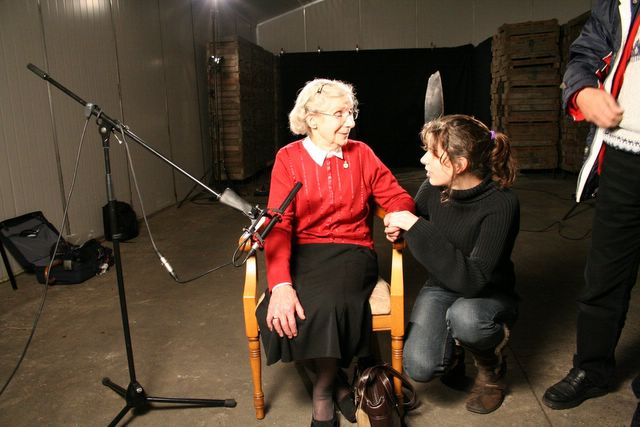
In an interview, that was
recorded for the documentary Memories in Mud, mrs Walsh explained why she wants
her brother back to Ireland. His name is allready on the family
grave in Tullamore.
She talked about her brother, who was a 'harem scarem'' and first didn't tell
he was flying for the RAF instead of working on the ground, like his parents
thougth.
About her mother, who expected a telegram of Jack reporting when he was coming
home to introduce his fiancee to his family. Instead, she got a telegram
about his missing in action. She never knew where her son was left after he
was 'Lost over Northern Holland'.
About her father, who wrote letters to everyone and every office to find out
if Jack perhaps was still alive. Somewhere, somehow.
About the reasons it took so long to find out where the exact spot of the plane
was: amongst others: Jacks name was spelled wrong in official papers. People
who searched for John E. Kehoe didn't find anything.
And Margaret Walsh-Kehoe talked about her mission, to get Jacks remains out
of the 'potato field': ,,I promised my mother I would bring Jack back to Ireland,
to bury him in consecrated ground. I still haven't fullfilled my mother's wish.
I want to do it before I die.''
You can watch the images of that day here
Look at the article on the website of Noordhollands
Dagblad
Or you can download an mp3 with
a recording of the Dutch Radio Noord-Holland, were you can hear Sheila Hamilton
reading the letter of her mother, and mrs Walsh talking about her brother.
Or read an interview with Ted Cachart,
chairman of the 49 Squadron Association, and veteran on a Lancaster bomber.
In the meantime, a spokesman of the community has announced that he expects that an excevation, if the new council (elections are in november) gives his consent in march, will be conducted after the summer of 2007. Earlier isn't possible because of the legal permits that are needed for environmental reasons. In november, a specialized company will examine the ground on the spot in Berkhout, to be able to report what the costs are for the operation.
Read here the story Sheila Hamilton wrote in the cristmas 2006 issue of the 4t9er, the magazine of the 49 Squadron Association.
On the 15th of march, 2007,
it is announced that the council of Koggenland will decide on 23th of april
if they will set aside 950.000 euro for the excavation of two bombers: the one
in Berkhout in september, and the one in ursem in october.
The mayor is optimistic about the outcome of the discussion. The community expects
to get 440.000 euro from the government.
On the 26th of march, a preliminary discussion about the proposal for the excavation, by a group of politicians who are also in the council, showed that all parties in the council are willing to cooperate. 'It's an enormous sum of money, but we have to handle this in a decent and dignified manner', the spokesman of PvdA said. The other members agree with him. VVD wondered if it is possible to begin earlier than september ('in june, july, it rains less') but mayor Sipkes said it isn't possible due to organizational reasons.
| On april 10, it is announced that a Lancaster bomber of the Battle of Britain Memorial Flight wil make a flypast above Berkhout and Ursem on april 28. The Lancaster is in the Netherlands to commemorate 'Operatie Manna', the dropping of food by Lancaster bombers of the Royal Air Force in april 1945. The food was brought to parts of the occupied Netherlands, with the acquiescence of the occupying German forces, to feed people who were in danger of starvation. | 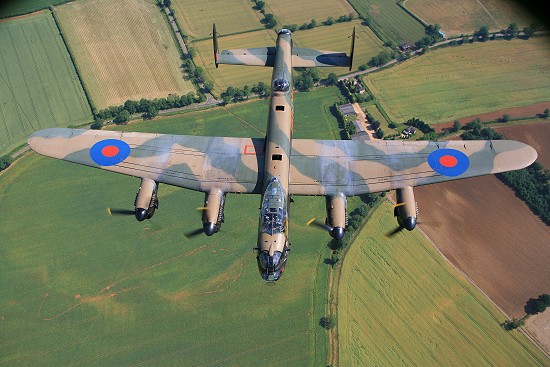 |
23 april 2007: As expected,
the council of Koggenland has decided to pay 950.000 euro for the excavation
of two bombers: the one in Berkhout in september, and the one in Ursem in october.
The council was unanimous. One of the most important reasons to say yes is the
request of mrs Walsh, one councilmember said: ,,a sister of someone who gave
his life for our freedom.''
28
april 2007:
'It
looks wonderful'
|
People
who know (from the 49 Squadron Association) said in advance: ,,The noise
of that plane is just incredible...'' and ,,It looks wonderful and sounds
like the sweetest music you ever heard.'' |
Silent for minutes
The Irish and British families and other persons involved were 'thrilled' and
'delighted' to hear the news the excavation wil go through. The daughter of
mrs. Walsh was silent for minutes.
Jan Uithol, president of the foundation of Dare and the Irish secretary, John
Gilroy, were particularly pleased about the fact the councilmembers spoke specifically
about fulfilling the request of the next of kin and 'handle this in a decent
and dignified manner', instead of 'clearing the wreckage and explosives'.
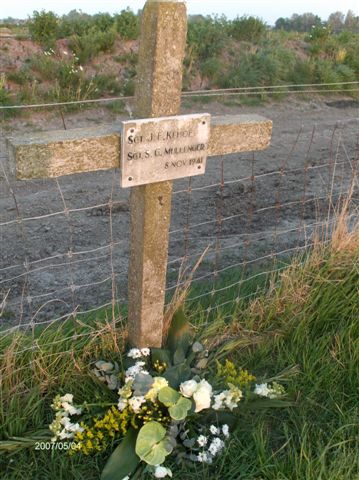
Photo Loek and Erika Schilder
As always on
May 4, Jack Sjerps of Koggenland laid down flowers near the cross on the field
in Berkhout, to commemorate the offer the crew of Hampden P1206 made. In the
Netherlands, Remembrance of the Dead (in Dutch: Dodenherdenking) is held annually
on this date. 19
mei 2007:
A
unique memorial on may 19 at RAF Scampton
|
- A
unique memorial on may 19 at RAF Scampton: Red Arrows make a flypast
with the 'missing man' formation, to commemorate the offer the crew
of Hampden P1206 made. Family of John Kehoe and Christopher Saunders
and other persons involved were witness. Family of Stanley Mullenger
and James d'Arcy weren't able to come. Click here for the article in the Lincolnshire Echo on the web.
|
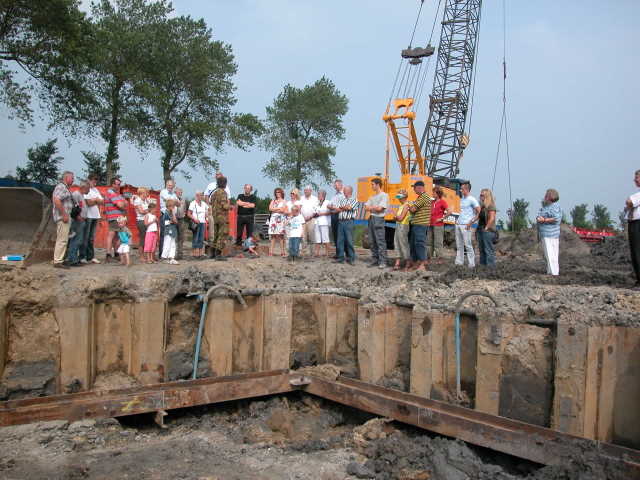 People get an explanation at an excavation site in Oude Tonge, earlier this year. In Berkhout and Ursem there will also be meetings for people who are interested in what happened in World War II. But visitors will not be allowed near the hole. The people on this picture in Oude Tonge were an exception, because it was only a small group of councilmembers and their family, at the moment that the work was done and the hole was empty. |
june 2007: Approx. 1150 households are summoned by the municipality of Koggenland. They are within circles of 1440 yard around the excavations of plane wreckages in Berkhout and Ursem and bombs that are expected to be found on two other places in that villages. For security reasons, people have to leave their houses for a couple of hours if in september or october bombs have to be dismantled. The excavation of Hampden P1206 will be the first, starting september 3. At the beginning, there will be a meeting for family of the crew, on the crashsite. Later on, twice a week, there will be afternoon meetings between and after working hours for educational reasons. Many teachers and other people prove to be very interested to get an explanation. That was expected. ,,Because it's World War II in our backyard'', mayor Sipkes said. The remains of Kehoe and Mullenger will be brought to a special identification unit in Soesterberg. It is expected Mullenger will be buried in a commonwealth grave in Bergen and Kehoe in his family grave in Ireland. What's left of the planes is property of the British, respectively American government. It is possible that some objects will be kept back for next of kin, or to be used for some kind of monument. The rest will be destroyed. Under no circumstance, the community will allow other people to take parts of the plane as a souvenir. |
British and Irish officials
have told the families involved it won't be possible to separate the remains
of John Kehoe and Stanley Mullenger... Their bones are partly deteriated after
66 years in the ground and investigation with the use of dna will take years.
The Irish sister of John Kehoe, mrs Margaret Walsh, is very dissapointed, her
daughter Margaret Tracey says, but she can find peace in the idea that they
will be buried in a commonwealth grave in Bergen, Noord-Holland. For that is
sacred ground. The main reason why she asked for the excavation is to get her
brother out of the ´potato field´his bomber crashed in. The family
of Stanley Mullenger allways said it would be the best thing to reunite the
crew in Bergen. Pilot Chris Saunders and navigator James d´Arcy were buried
their right after they were found at the crash site on the 8th of november,
1941.
The Irish family hope it will be possible to have the funeral in due time, for
Margaret Walsh (88) ,,doesn't have much time left...'' According to Dutch officials,
normally it takes ten to fourteen months for the forensic examination and organisation
of the funeral, because a lot of parties are involved. Brian Louden, assistant
defense-attaché at the British Embassy in The Hague, expects it will
be possible to have the reburial in the spring of 2008.
For the last news,
look at the main page. The newest articles have an link to an English translation..